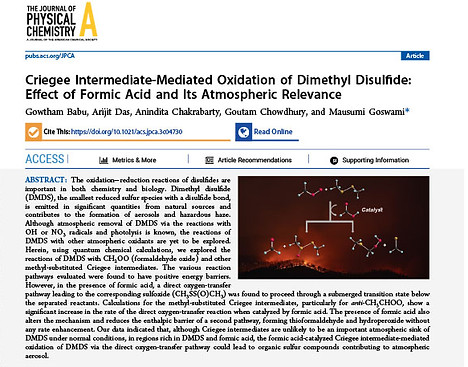top of page

Atmospheric Chemistry
Deciphering the mechanism of Atmospheric reactions of Criegee Intermediates
Criegee intermediates are key intermediates generated during the oxidation of unsaturated hydrocarbons by ozone in the troposphere. The criegee intermediates (CIs) contribute to the formation of organic acids and hydroperoxides in the atmosphere and act as the primary source for the production of hydroxyl radicals during night-time and winter season. Oxidation process involving CIs are important in regions with large emission of volatile organic compounds, especially in regions with large concentration of ozone and alkene. A significant amount of CIs can be formed in the atmosphere and understanding their chemistry is important. This research project is aimed towards understanding the mechanism and kinetics of CI reactions in the atmosphere.
Molecular Mechanism of Aerosol Formation
Formation of aerosols involves two steps-nucleation, and subsequent condensation and growth. The presence of certain atmospheric molecules can enhance the nucleation process. Our current goal is to investigate the molecular mechanism of such processes.
Atmospheric Hydroperoxides and their degradation in atmospheric condensed phase
This project investigates the transformation mechanism of atmospheric hydroperoxides using different analytical tools augmented with theoretical methodologies. The ultimate goal is to understand the contribution of hydroperoxides to aerosol formation.
Interstellar Chemistry
High-resolution Spectroscopic study of molecular systems of astrophysical significance by Chirped Pulse Microwave Spectroscopy
Radio Astronomy is a technique which is used to measure rotational spectroscopic signature of molecules in space and is the cornerstone of observational astronomy. More than 180 molecules have been detected in space using Radio Astronomy. In order to decipher the large volume of acquired astronomical data, laboratory rotational spectroscopy of the species of interest is essential. Accordingly, I propose to identify and analyze the rotational spectroscopic signatures of astrochemically and astrophysically relevant molecules under laboratory conditions. The goal is to create transient or elusive molecules under laboratory conditions and measure their rotational spectrum which will aid in their radio astronomical observation in the interstellar environment.
Theoretical Kinetic Investigations of the mechanism of organic molecules formation in dense interstellar Cloud
Biophysical Chemistry
Mechanistic and kinetic investigation of the mode of action of the anti cancer drug Sepantronium bromide

bottom of page